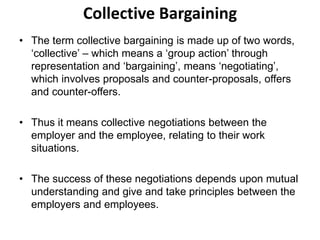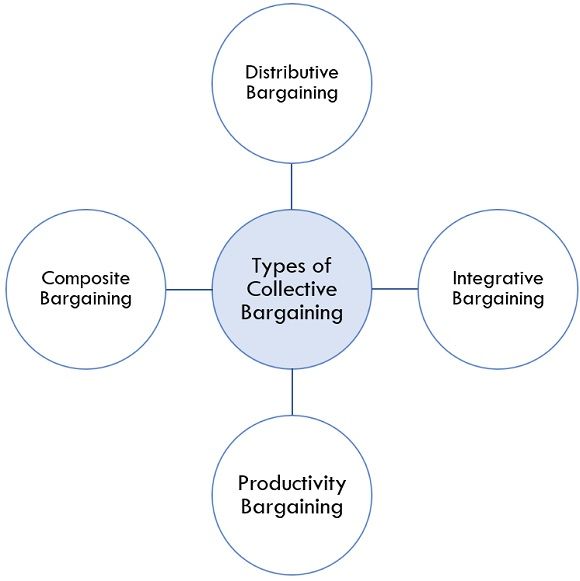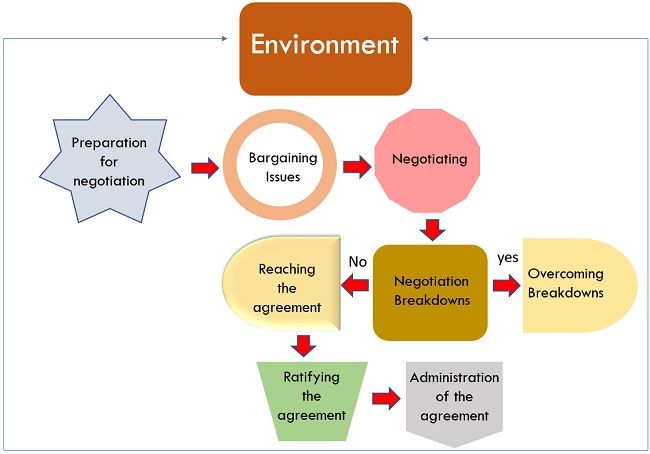Explain Different Methods of Collective Bargaining
It is a Continuous Process. Distributive Bargaining Strategy Distributive bargaining is defined as negotiations that seek to divide up a fixed amount of resources a win-lose situation.
When workers are individuals then it can be difficult to negotiate with an employer.

. In this type of bargaining the employers and employees try to maximise their respective gains. Collective bargaining involves discussion and negotiation between two group as to the term and conditions of employment. Main Features of Collective Bargaining.
In this form of bargaining it is seen as a zero-sum game with limited resources to be distributed according to the strength. To ensure that trade union is given due recognition. Unions insist on the point that bargaining can be effective only if workers in any one job are guaranteed a specified minimum wage per piece or per month.
Distributive Bargaining Integrative Bargaining. Collective bargaining is a group action as opposed to individual action. It incorporates the process of negotiation administration and interpretation of the collective agreement.
In this situation workers and firms may find a way to increase wages and. Many non-union workers are faced with a take it or leave it type of offer. In the initial industrialization era the workers had to fight with the management for their rights.
Process of Collective Bargaining Negotiation Team Preparation of Demands Negotiating Procedure Bargaining Strategy and a Few Others The term collective bargaining refers to the negotiation administration and interpretation of written agreement between two parties that covers a specific period of time. The collective bargaining process can take time. Determining priorities on each side.
It is called collective because both the employer and the employee act as a group rather than as individual. To foster industrial democracy. Redesigning the machinery of bargaining.
One is the traditional method in which one party comes to the table completely unaware of problems that the other party is facing. Concession bargaining is a method of collective bargaining that sometimes takes place when the employer is in distress. Distributive or conjunctive bargaining This type of collective bargaining in walls zero-sum negotiations and is considered as the most common type of bargaining.
To promote cordial and harmonious relations between the employer and the employees. The primary goal of collective bargaining is the achievement of a. Conjunctive or Distributive Bargaining.
Ascertaining the form of compensation. Based on this there are five essential forms of collective bargaining. Standardisation is one such technique.
The phrase collective bargaining was coined by Sydney and Beatrice Webb and according to their definition it is a method by which the trade unions strive to protect and improve the working conditions of the workers. Types of Collective Bargaining It can be classified into five major types Distributive Bargaining. It discusses redistribution of profit sharing to increase wages bonuses or financial benefits.
Different types of collective bargaining. Types of Collective Bargaining. Are negotiated under conjunctive bargaining.
It means the establishment of a uniform minimum price for each class of work. For example a union may give up paid time off in exchange for protection for layoffs. 2 types of bargaining strategies are.
The principle my gain is your loss and your gain is my loss is practiced in conjunctive bargaining. There are four types of Collective Bargaining classified on the basis of their nature and the objectives and can be practiced depending on the different situation requirements. In interest-based bargaining both sides bring issues to the table and resolve those issues by mutual agreement.
Collective bargaining is a continuous process and does not end with one. The NLRA stipulates which bargaining subjects are mandatory permissive or illegal. The differences between collective bargaining in the public and private sectors are well understood by students of the subject but often ignored by legislators and the public.
Laws governing public employee unions and collective bargaining in the public sector all levels of government including local school districts are often modeled on similar legislation governing. This is the type in which one side wins and the other team loses completely. According to Edward J 2003 two methods are followed for collective bargaining.
In this type of negotiation process one party benefits at the expense of others. In proposal bargaining both sides write proposals for changes to the contract. Negotiating begins in earnest.
Both the parties of settlement are represented by. Collective bargaining gives workers a larger voice. Both parties prepare for the process by gathering information and reviewing the old contract.
When looking at the types of collective bargaining it is important to distinguish it between a collective agreement. A bargaining impasse occurs when members cannot come to an agreement. The employee and the employer try to maximize their respective gains.
Formulating the rules of the workplace. 7 Steps in Collective Bargaining 71 Acknowledging and identifying the problem 72 Collection of facts and data 73 Selection of representatives 74 Starting the negotiation process 75 Bargaining Strategy 76 Reaching to an agreement 77 Formalizing and Enforcing the agreement 8 Importance of Collective Bargaining 81 Importance to Employees. The second technique is restriction of membership.
There are also different types of collective agreements but these refer to the o. Types of Bargaining 1. Issues like wages bonus etc.
In this situation the union may give the employer back a previous agreement in exchange for job security for the largest number of employees. The functions of collective bargaining are. In this form of collective bargaining both the parties viz.
Major objectives of collective bargaining are. They then set time lines for the bargaining and reveal their wants and negotiate those wants. To keep the third party at bay.
If an employee doesnt take it then the employer will hire someone who does. Collective bargaining is the process by which a labor union and employer negotiate over the terms of the employment relationship. To protect the interests of both employer and employee.
It is a Group Action.

What Is Collective Bargaining Defintion Process Agreement Types And Importance The Investors Book

What Is Collective Bargaining Defintion Process Agreement Types And Importance The Investors Book

Collective Bargaining Definition 5 Types And 3 Examples Boycewire

Negotiating Our Way Up Collective Bargaining In A Changing World Of Work Oecd Ilibrary
No comments for "Explain Different Methods of Collective Bargaining"
Post a Comment